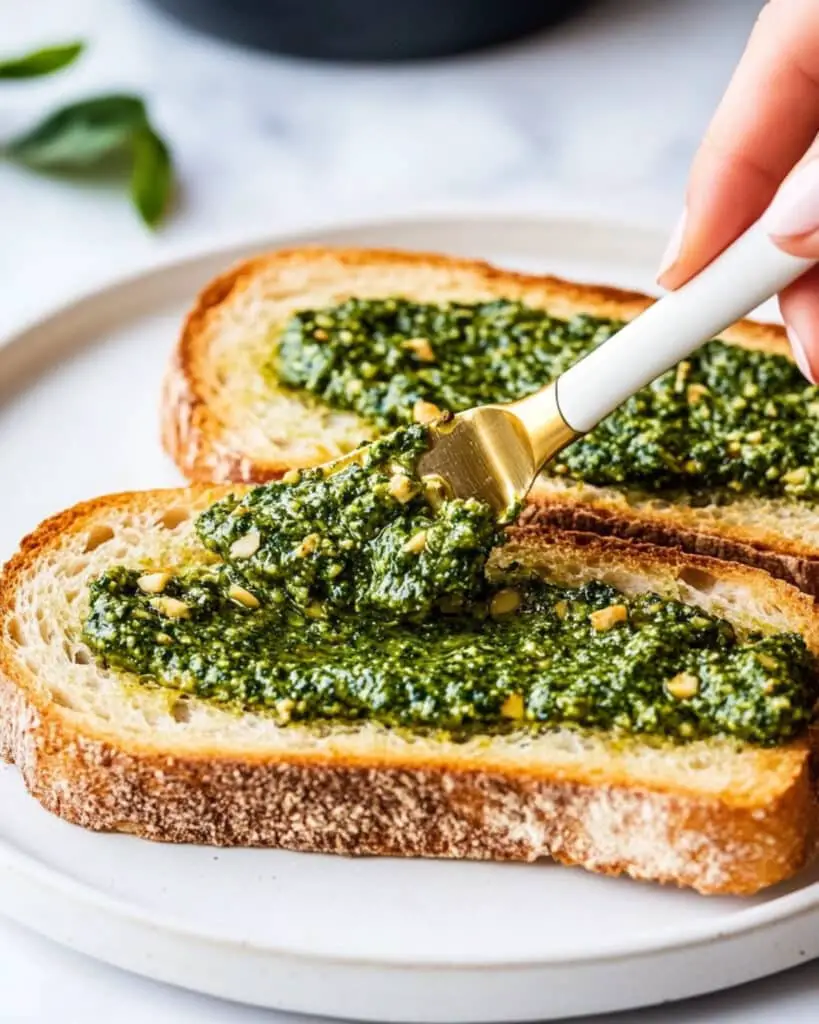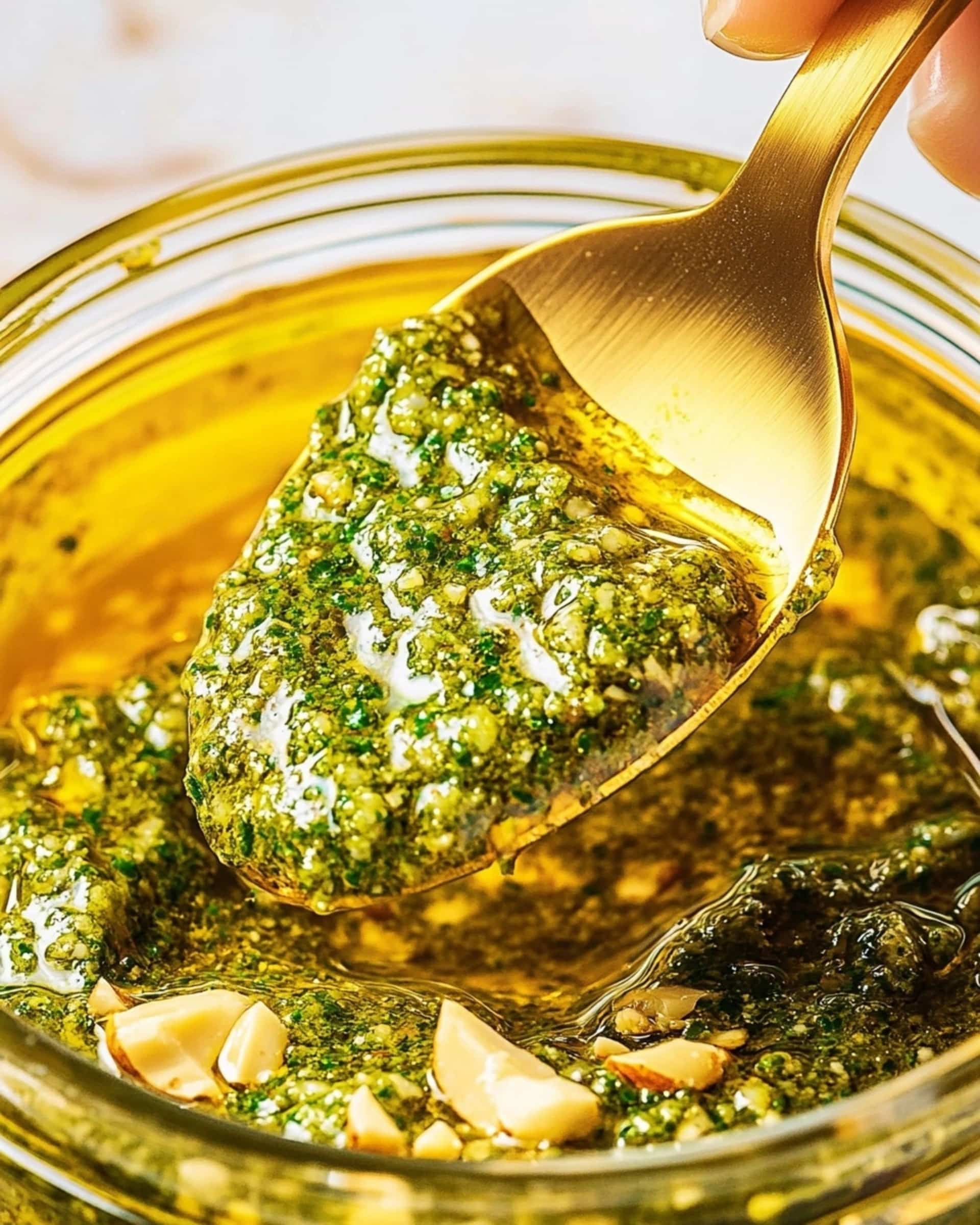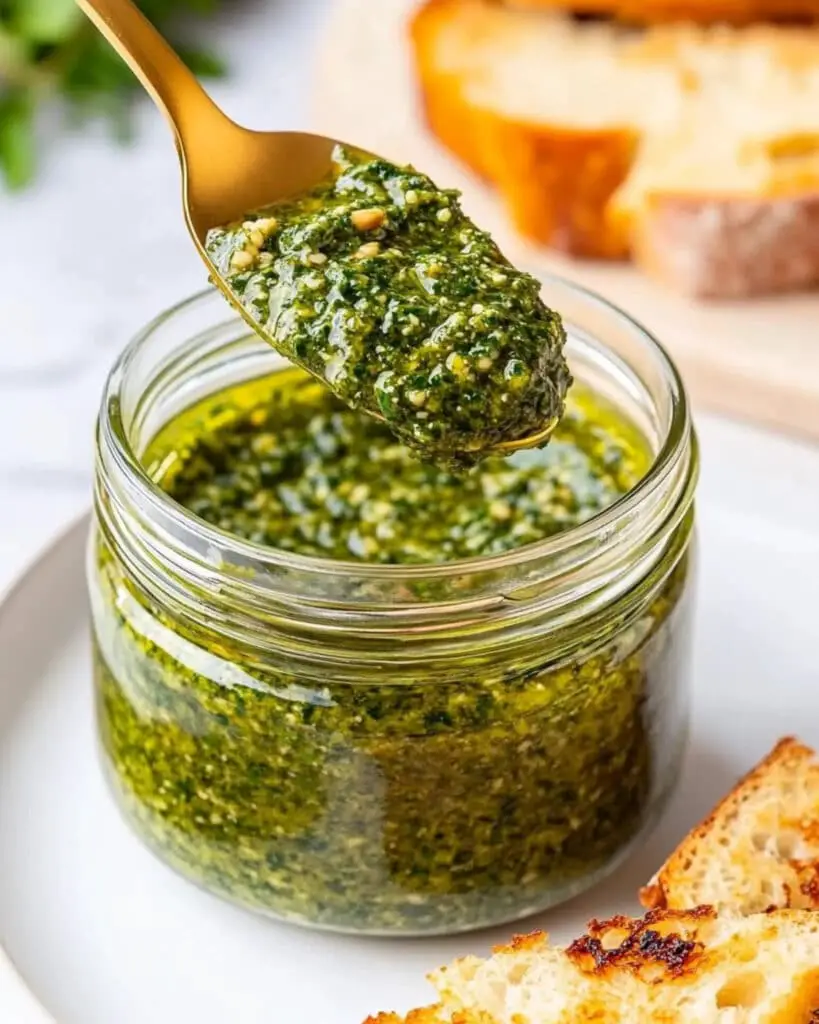This vibrant Basil Pesto Sauce with Walnuts is a game-changer for your kitchen repertoire. Ready in just 5 minutes, this aromatic sauce transforms ordinary dishes into extraordinary meals with minimal effort. The combination of fresh basil, toasted walnuts, and quality olive oil creates a versatile condiment that’s both richly flavored and wonderfully nutritious.
Why You’ll Love This Recipe
- Lightning Fast: From garden (or grocery bag) to table in 5 minutes flat! Perfect for those evenings when cooking feels like a chore.
- Incredibly Versatile: This isn’t just pasta sauce – it’s a flavor bomb for sandwiches, vegetables, proteins, and more. One batch can transform multiple meals throughout your week.
- Fresher Than Store-Bought: Nothing compares to homemade pesto. The vibrant color and complex flavors will make you wonder why you ever settled for the jarred stuff.
- Nutrient-Dense: Packed with heart-healthy fats from walnuts and olive oil, plus all the goodness of fresh basil and garlic.
Ingredients You’ll Need
- Fresh Basil Leaves: The star of the show! Their sweet, peppery flavor forms the foundation of any great pesto. Make sure they’re bright green and aromatic for the best flavor.
- Walnuts: A delicious twist on traditional pine nuts, offering a more complex flavor profile and extra nutrition. Plus, they’re typically more affordable!
- Garlic: Adds that essential punchy backbone to the sauce. Fresh is non-negotiable here – pre-minced just won’t deliver the same bright flavor.
- Extra Virgin Olive Oil: Use the good stuff for this recipe! The flavor of your olive oil significantly impacts the final product, so reach for something fruity and robust.
- Parmesan Cheese: Brings saltiness, umami, and that special something that ties everything together. Freshly grated makes a world of difference compared to pre-grated options.
- Salt and Pepper: Simple seasoning that lets you customize the flavor to your preference. I recommend starting with less salt since the Parmesan already contributes saltiness.
Note: You’ll find the complete list of ingredients, along with their exact measurements, in the printable recipe card at the bottom of this post.
Variations
This pesto is incredibly adaptable. Here are some exciting twists to try:
- Nut Alternatives: Swap walnuts for almonds, pistachios, or traditional pine nuts. Each brings its own character to the sauce.
- Cheese Variations: Try pecorino for a sharper flavor or mix in some ricotta for a creamier result.
- Herb Blends: Substitute some of the basil with parsley, mint, or arugula for interesting flavor combinations.
- Lemon Lover’s Pesto: Add lemon zest and a squeeze of juice for brightness.
- Spicy Kick: Incorporate a pinch of red pepper flakes for heat.
How to Make Basil Pesto Sauce with Walnuts
Step 1: Combine Base Ingredients
Add your basil leaves, toasted walnuts, and minced garlic to the food processor. Pulse several times until everything is coarsely chopped but not pulverized. You want texture, not a smoothie!
Step 2: Add Olive Oil
With the processor running, slowly drizzle in the olive oil through the feed tube. This gradual addition creates an emulsion that gives your pesto that perfect, silky consistency. Keep processing until smooth but still maintaining some texture.
Step 3: Incorporate Cheese
Add the freshly grated Parmesan cheese and pulse a few times just to mix it in. Don’t over-process at this stage – you’ll lose the wonderful texture.
Step 4: Season to Taste
Add salt and freshly ground black pepper to taste, then pulse briefly to incorporate. Remember, you can always add more seasoning, but you can’t take it away!
Step 5: Final Adjustments
Give your pesto a taste test. Need more punch? Add more garlic. Not creamy enough? A touch more oil. Too thick? A splash of water can loosen it without diluting the flavor much.
Step 6: Store Properly
Transfer your finished pesto to a jar or container. If not using immediately, pour a thin layer of olive oil on top to prevent oxidation (which causes browning).
Pro Tips for Making the Recipe
- Blanch the Basil: For a more vibrant green color that lasts longer, briefly blanch basil leaves in boiling water (5 seconds), then shock in ice water before drying thoroughly.
- Toast Walnuts Properly: Don’t rush this step! Gently toast them in a dry skillet over medium-low heat, shaking frequently until fragrant – about 5-7 minutes. This dramatically improves their flavor.
- Room Temperature Cheese: Parmesan that’s not straight from the refrigerator incorporates more smoothly.
- Pulse, Don’t Puree: Maintain some texture by using the pulse function rather than running the processor continuously.
- Season at the End: Add salt after the cheese is incorporated since Parmesan already contributes saltiness.
How to Serve

This versatile pesto shines in countless applications:
Classic Pairings:
- Toss with hot pasta (reserve some pasta water to thin the sauce if needed)
- Spread on toasted baguette slices for bruschetta
- Swirl into soups just before serving
- Dollop onto a pizza after baking
Unexpected Delights:
- Stir into scrambled eggs or an omelet
- Use as a marinade for chicken or fish
- Mix with mayo for a next-level sandwich spread
- Drizzle over roasted vegetables or a simple caprese salad
- Blend with softened butter for an incredible compound butter
Make Ahead and Storage
Storing Leftovers
Store your pesto in an airtight container in the refrigerator with a thin layer of olive oil on top to prevent oxidation. It will keep fresh for up to 5 days.
Freezing
Pesto freezes beautifully! Portion it into ice cube trays, freeze until solid, then transfer the cubes to a freezer bag. These pesto cubes will maintain quality for up to 3 months and can be thawed as needed.
Tip: For freezing, some cooks omit the cheese and add it fresh after thawing for the best texture.
Reviving Refrigerated Pesto
Cold pesto from the fridge might look slightly separated or dull. Let it come to room temperature and give it a good stir before using. A drizzle of fresh olive oil can also revive its consistency and flavor.
FAQs
-
Can I make pesto without a food processor?
Absolutely! While it takes more effort, you can use a mortar and pestle for a more rustic texture – many culinary purists actually prefer this method. You can also use a blender, though you may need to stop and scrape down the sides more frequently.
-
Why did my pesto turn brown?
Basil oxidizes quickly when exposed to air. To prevent browning, always top your stored pesto with a layer of olive oil, and consider adding a squeeze of lemon juice to the recipe. The acid helps maintain the bright green color.
-
Is there a dairy-free alternative?
Yes! Simply omit the Parmesan and add nutritional yeast for a similar umami flavor, or substitute with a dairy-free Parmesan alternative. You might want to add a bit more salt to compensate for the missing cheese.
-
How can I make my pesto less bitter?
If your pesto has a bitter edge, try these fixes: make sure you’re using only the leaves (not stems) of the basil, toast your walnuts more thoroughly, or add a tiny pinch of sugar to balance the flavors. Using young, fresh basil leaves also helps prevent bitterness.
Final Thoughts
This Basil Pesto Sauce with Walnuts isn’t just a recipe – it’s a kitchen superpower. In just 5 minutes, you create something that transforms everyday ingredients into memorable meals. The vibrant color, intoxicating aroma, and complex flavors make this worth making again and again. Whether tossed with pasta, spread on sandwiches, or dolloped on proteins, this pesto brings a touch of gourmet to your everyday cooking. Give it a try – your taste buds will thank you!
Print
Basil Pesto Sauce with Walnuts Recipe
- Prep Time: 5 minutes
- Cook Time: N/A
- Total Time: 5 minutes
- Yield: 1 cup
- Category: Sauces-condiments
- Method: Blending
- Cuisine: Italian
- Diet: Vegetarian
Description
This vibrant and flavorful Basil Pesto Sauce with Walnuts brings a delightful twist to the classic recipe. Packed with fresh basil leaves, toasted walnuts, and Parmesan cheese, this creamy and aromatic sauce is perfect for pasta, sandwiches, pizza, or as a dipping sauce. Its nutty undertones and rich olive oil base create a well-rounded, versatile condiment you’ll always want on hand!
Ingredients
- 2 cups fresh basil leaves, packed
- 1/3 cup toasted walnuts
- 3 garlic cloves, minced
- 1/2 cup extra virgin olive oil
- 1/2 cup grated Parmesan cheese
- Salt and pepper to taste
Instructions
- Prepare and Combine Basic Ingredients
In a food processor, combine the fresh basil leaves, toasted walnuts, and minced garlic. Pulse several times until coarsely chopped. This forms the base for your pesto, so aim for a texture that’s not fully smooth yet. - Incorporate Olive Oil
With the food processor running, slowly stream in the extra virgin olive oil. Blend until the mixture becomes smooth and well-combined. The olive oil not only binds everything together but also gives the pesto its rich and velvety texture. - Add Parmesan Cheese
Add the grated Parmesan cheese to the processor. Pulse several times to ensure everything is evenly incorporated, enhancing the pesto’s savory and nutty flavor. - Season the Pesto
Add salt and freshly ground pepper to taste. Pulse briefly to mix the seasoning. Make sure to taste your pesto and adjust as needed to suit your preference. - Store Safely
Transfer the pesto sauce to an airtight jar or container. If you’re not using it immediately, cover the surface with a thin layer of olive oil to prevent oxidation. Store it in the refrigerator for up to a week or freeze for longer storage.
Notes
- Don’t Over-Process: Be careful not to run the food processor for too long as over-processing can dull the texture and freshness.
- Toast the Walnuts: Lightly toast the walnuts in a pan over low heat for a deeper, nuttier flavor. This step is worth it!
- Use High-Quality Ingredients: Opt for high-quality extra virgin olive oil and the freshest basil leaves for the best flavor.
- Beyond Pasta: While pesto is best known as a pasta sauce, try it as a topping for pizza, a spread in sandwiches, or even mixed with scrambled eggs.
Nutrition
- Serving Size: 2 tablespoons
- Calories: 200
- Sugar: 1g
- Sodium: 160mg
- Fat: 22g
- Saturated Fat: 4g
- Unsaturated Fat: 18g
- Trans Fat: 0g
- Carbohydrates: 2g
- Fiber: 1g
- Protein: 3g
- Cholesterol: 5mg









